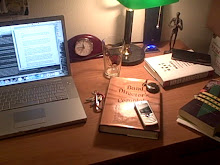This post is part of a blog project on Student Teaching hosted at So You Want to Teach
Instead of working, I drove down to Stockton to sort out the rest of my life.
After interviewing with the faculty, (who are awesome) I was told that as long as I filled out the paperwork I was guaranteed tuition remission for 9 units of study per semester for two years. 9 units, with a 20 hour assistantship AND student teaching is a full load. If I get everything in and they have the money, they'll even toss in a 3,000 stipend per semester - which, considering I won't be able to hold down a job that doesn't require me to work during normal business hours (school), or nights (rehearsals), would be pretty much necessary. I'm in a far better state of mind now than 6 months ago when I got the acceptance letter. I know my parents read this, and they can breathe a little easier now.
So, buoyed by some promise of a future, I sat in on the rehearsal of Pacific's Wind Ensemble, under the direction of Dr. Eric Hammer (under whom I'll be working as my graduate advisor next year).
This is an auditioned ensemble of conservatory musicians, all of whom are miles beyond me in any aspect of performance (Shh! don't tell anyone). But, what impressed me the most was the balance and instrumentation of the group. Used to a high school or general college wind ensemble, this group surprised me by having each part in the score covered by one or two musicians. Instead of fifteen flutes or clarinets, there were six each - balanced by three oboes, three bassoons, a bass clarinetist, four horns and a sax quartet, 5 trumpets, 3 bones, euphonium and a tuba.
This was professional instrumentation, and they were sailing through pieces like John Barnes Chance's Blue Lake Overture (Track 6), and Copland's Lincoln Portrait (9:40 in the interview)- a piece that I've loved since I had to rip it apart for a ten page paper for an American Studies class on semiotics and images in society.
However great the ensemble was, it was due to its director, and I want to bring to light some observations of rehearsal techniques he used that I want to adopt for my own.
- Ear training. - This is something I'm sure high school teachers wrestle with: how much time to spend rehearsing the music, and how much time to spend on things like theory when the class is designed to be little more than a performance opportunity. If I have the chance as a high school teacher, I'm going to remove all work required by a marching program during rehearsal in the students first year to focus on theory.
Dr. Hammer started rehearsal off by getting everyone to hum America the Beautiful off of the B flat they tuned from (casting it in the key of E flat), then play it, then sing it in Solfege and play it again, which fixed all the problems. It was impressive watching the student's theory brains kick as they figured it out. He does this with a new song every rehearsal. - "Sizzling" - Air control. I know how important it is, but it's something that I practice on my own, usually with buzzing, and definitely not in rehearsal. Dr. Hammer had the students "sssss-ing" their parts for part of the Blue Lake Overture, and while he conducted it, I could hear the phrasing and dynamics with just their air. I could focus on the melody bouncing around the room and afterwards, something clicked with the students and the entire piece had more substance behind it - it wasn't heavier, just more massive - if that makes sense.
- Metronomic Abandonment - They are planning on including the Washington Post March in their concert just in time for President's day, and what surprised me was after all their work, they started falling apart on Sousa. They were stretching the time at the trio, and people weren't watching the director, it started to bounce along like an accordion, stretching out to compensate for speeding up, etc. In a response to this, Dr. Hammer placed his right hand behind his back after a preparatory beat and only gave artistic gestures and cues with his right and, leaving the band to fend for itself, and forcing them to listen to each other. This might end up in a trainwreck with younger groups, but the awareness sudden awareness of a lack of visual cues caused many to focus more on listening.
It cleaned up well. - Itinerary - Dr. Hammer conducted all business at the end of the rehearsal. At the top, he had a sheet with everything on it, and students picked it up as they walked in. It had a breakdown of every piece to be played during the 1.5 hour rehearsal, and a meticulously structured schedule on how much time was to be spent on each piece. This allowed the rehearsal to move swiftly and orderly, and end with reminders and motivation on the part of the director. Also included on the itinerary, which the students took home with them was everything for Wednesday's rehearsal, and what they needed to practice to be prepared. A little much, but the smoothness with which the rehearsal ran was testament to the order and discipline of the group.
To sum it up, I'm really excited and am chomping at the bit to work with someone whose conducting is as controlled and powerful as it is fluid and graceful, and am looking to get some real feedback on my own.
Is it August yet?

No comments:
Post a Comment